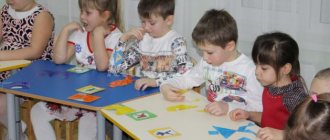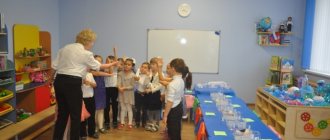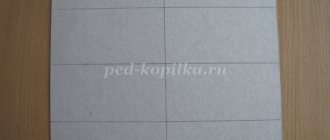Formation of temporary representations in preschool children
The article reveals the theoretical aspects of the formation of time concepts in preschoolers, as well as ways and means of developing a “sense of time”.
Key words: formation of temporary representations, preschool children, ways, means.
Time is one of the links of reality in which we exist. All events in the surrounding reality of the world occur in time. It disciplines our life and activities, we are subject to its course, although sometimes we don’t notice it.
Modern life is characterized by sudden changes in rhythms, lack of time and unprecedented speeds. Today, a person of any profession and age needs the ability to subtly sense it and use it rationally. Therefore, a modern person needs to be able to adapt to changing conditions and quickly respond to the times.
Many teachers have studied the formation of ideas about time in preschool children. Thus, Ya. A. Kamensky in “The Great Didactics” pointed out that by the age of six, the child should have the core for many subsequent activities. He pointed out that the education of preschoolers must go through the “first steps of chronology” [2].
According to F. Froebel, the child should learn the first ideas about time in the process of practical games, in games and in classes with educational material.
E.I. Vodovozova was interested in the question of the amount of knowledge for preschoolers. She believed that it was enough for children to know the sequence of days of the week and the order of the seasons. She suggested that children master such concepts as “noon”, “twilight”, and introduce them to the cardinal directions [1].
Under the leadership of A. M. Leushina, the content and methods of forming time concepts in preschoolers were developed. Preschoolers mastered abstract concepts through the assimilation of practical actions and in practice-oriented activities. The content of temporary concepts developed by A. M. Leushina is widely represented in educational programs. This was a significant difference from foreign educational programs[3].
The theoretical aspects and practical recommendations of M. I. Vasilyeva on the development of temporal representations are interesting. Her works describe the role of time in regulating a child’s behavior and activities. The result of the work is that preschoolers began to perform certain actions more quickly and spend it sparingly on everyday processes.
R. Chudnova offers ways to teach time orientation. The author recommends the widespread use of pictures and literary words: proverbs, stories, poems, riddles. To improve knowledge about time, R. Chudnova developed visual models “Parts of the day”, “Days of the week”, “Seasons” - symbols of the year and seasons. When using this material, the author recommended taking into account the age and individual characteristics of the students [7].
T. D. Richterman also identifies the main specific aspects of children’s perception of time, clarifies the tasks, and offers a variety of work methods. The author offers an introduction to the parts of the day on a visual basis - using pictures that reflect the activities of children in different parts of the day. Next, the author suggests switching to learning pictures with images, where each time of day is indicated by a different color. To generalize knowledge about time, T. D. Richterman suggests introducing older preschoolers to the calendar as a system of time measures [5].
E.I. Shcherbakova also studied the formation of time ideas and concepts (day, week, year) in preschoolers, some properties of time (one-dimensionality, fluidity, irreversibility), and was also interested in primary practical orientation in time. She developed a three-dimensional model of time in the form of a spiral, each curl of which, depending on the solution to a specific didactic task, clearly showed the movements of changes in processes and phenomena of time. The author also created the “Days of the Week”, “Seasons” model, which promotes children’s understanding of the real moment, provides children with the opportunity to look into the “laboratory of time”, see and understand its essence [8].
The perception of time has its own characteristics
, so the phenomena of objective reality are characterized by a certain duration, therefore the perception of time is, first of all, a reflection of the duration of the phenomena of objective existence, their flow within a particular period of time.
As in any perception, the basis is the sensory perception of time. There is no special time analyzer. Various properties of time are reflected by a certain set of analyzers with the leading role of one of them. I.M. Sechenov attached special importance to auditory and muscle sensations, believing that “only sound and muscle sensation give a person an idea of time, and not with all their content, but only one side, the viscousness of the sound and the viscousness of the muscular feeling” [6].
So we can distinguish five features of time. It is characterized by fluidity
: not a single, even the smallest, unit of time can be perceived immediately, but only in its sequential flow, that is, the beginning of an event is recorded, and when its end comes, one can only remember the beginning.
The next feature is the irreversibility
of time: you cannot return the moment that has passed.
Time is inaccessible to direct contemplation
: it is “not visible”, “not heard”;
it has no visual forms. Over time, no action can be taken
.
Any action takes place in time, but not with time. Time can only be lived. And the last feature, verbal designations of time are conditional
, relative, unstable and of a transitional nature.
The “sense of time” can be at different stages of development. At an early age, it is formed on the basis of sensory experience without relying on knowledge of temporary standards. This is how a baby screams when it’s time to feed him. He does not have a generalized concept of “sense of time”; it is associated only with specific activities. This feeling grows and improves in the process of specially selected exercises and mastering methods of assessing time. In such cases, it begins to play the role of a regulator of activity.
Time orientation is vital for a child as a future member of society and serves as the basis of his personal culture. The ability to navigate in time gives children the opportunity to develop successfully, master various types of activities, explore the world around them and, thus, prepare for school. The level of development of temporal concepts in children is one of the important indicators of intellectual readiness for school and is identified through pedagogical and psychological diagnostics.
Many positive qualities arise and develop thanks to the child planning his activities over time, for example: focus, composure, organization, etc. In playful, productive activities, children learn to regulate the pace and rhythm of their actions, and take into account the time factor.
But the development of temporal concepts by a preschool child is slow and difficult. The reasons for this are various. So R.L. Nepomnyashchaya identifies the following, the first reason is the uniqueness of time as a form of manifestation of reality. The second is the immaturity of the child’s mechanisms of time cognition. The third is the characteristics of children's thinking and cognitive activity at an early age. And the fourth reason is the child’s little experience of living in time.
Therefore, when introducing preschoolers to time concepts, it is necessary to be based on the age and individual characteristics of the children. It is necessary to start by familiarizing children with the units of its measurement. Systematic work in an educational institution on the development of temporal concepts begins at the age of three. In each age period, the teacher directs his efforts to solving certain problems, which as a whole constitute a program that guides the teacher in his activities.
Analyzing the program “From birth to school” edited by N.E. Veraks [4], we found that in the second youngest group, children are taught to navigate contrasting parts of the day: day - night, morning - evening. In the middle group, the ideas of preschoolers are expanded by characterizing the sequence morning - day - evening - night. Then, in older preschool age, children are given the idea that morning, evening, day and night make up a day. They learn to establish the sequence of events, for example, what happened before and what happened next. And already in the preparatory group, children are given elementary ideas about time: its fluidity, periodicity, irreversibility, the sequence of all days of the week, months, seasons. They learn to distinguish the duration of individual time intervals: 1 minute, 1 hour.
After conducting a theoretical analysis of the literature, we found that the development of ideas about time in children in kindergarten is carried out in two ways: through everyday life and in the classroom. Both paths can be combined with each other. In everyday life, it is useful to rely on a daily routine, a clear routine in the alternation of various types of activities. In addition to the child’s own activities, examples from the lives of other people, as well as natural phenomena, observations of which contribute to the recognition of parts of the day and seasons, are used as reference points.
Work to familiarize children with time should have a clearly practical orientation. In the process of work, it is important to use a wide variety of means: observations, didactic games and exercises, examination of illustrations and models, modeling, reading works of art (poems, fairy tales, stories, proverbs, sayings, riddles), etc.
Thus, in modern conditions of social development, solving such a problem as the development of temporary concepts is of particular relevance. It is important to use a variety of means when working with preschoolers. The work should be carried out not only during educational activities, but also during the day and at regular moments.
Literature:
1. Vodovozova, E. N. Mental and moral education of children from the first appearance of consciousness to school age: A book for educators / E. N. Vodovozova. - St. Petersburg, 1913.
2. Komensky Ya. A. Great didactics. — Fav. Ped. op. - / Ya. A. Kamensky, M.: 1955.
3. Leushina, A. M. Formation of elementary mathematical concepts in preschool children. / A. M. Leushina - M., 1974
4. From birth to school. Approximate basic educational program for preschool education / Ed. N. E. Veraksy, T. S. Komarova, M. A. Vasilyeva. — 3rd ed., rev. and additional - M.: MOSAIKA-SYNTHESIS, 2015. - 368 p.
5. Richterman, T. D. Formation of ideas about time in preschool children. / T. D. Richterman - M. - 1982.
6. Sechenov, I. M. Reflexes of the brain. Selected works / I. M. Sechenov. - M., 1952. S. 77–78.
7. Chudnova, R. Teaching children time orientation / R. Chudnova // Preschool education. - 1989. - No. 7. - No. 1. - P. 24–29.
8. Shcherbakova, E. I. Methods of teaching mathematics in kindergarten. / E. I. Shcherbakova. - M., 2000.
The principle of active participation in the learning process
Features of the principle - only the knowledge that has aroused the child’s interest and active participation in its assimilation is acquired. If the child does not care about what is happening, then information received from the outside will pass by and not be perceived by the brain.
The child must take part in learning
While working with children, the teacher must provide techniques that activate interest in knowledge and thinking. The fact that the child receives information chewed up in detail, the assimilation of which does not require his time and energy, has a negative impact. It may seem simple and understandable, but the lack of personal involvement makes it distant and uninteresting. There needs to be a balance in the parenting process.
Cognition should be the solution of practical problems, activity, independence. The basis of such ideas is the indicative-exploratory reflex.
The principle of the relationship between training and development
These two processes are interconnected and continuous, but at the same time they require patience. Just yesterday the baby couldn’t do anything, but today he is mastering different skills. All this is natural and natural. If at any stage in your training there are difficulties, you just need to be patient and move forward.
The relationship between learning and development in preschoolers
It is very important to awaken in a child a desire for independent knowledge, then the child himself will strive to learn new and interesting things.
Be sure to praise your child and create a situation of success - this is the surest incentive. Love children, then you will certainly succeed. leave a comment




